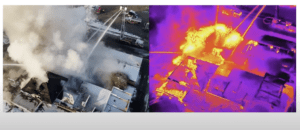Teledyne FLIR‘s VUE TZ20-R is a game changer for commercial drones, for applications from search and rescue to solar inspection. In a recent webinar, Teledyne FLIR’s Kelly Brodbeck gives 4 reasons drone pilots need radiometric thermal zoom capabilities.
The VUE TZ20-R’s radiometric thermal zoom capabilities are the result of careful market research. Since FLIR was acquired by Teledyne last year, “We’re a much bigger company these days,” says Brodbeck. “Our combined companies really do address all of the measurement, imaging and data gathering you can do across the magnetic spectrum.” Teledyne FLIR’s products are working on land, air and sea all around the world, and even on other planets – but some elements of imaging are constant.
“Getting closer to your subjects is always a good thing,” Brodbeck says. “On a drone, when you can’t be very close to your subject, it’s essential.”
What is Radiometric Thermal Zoom?
All photographers understand what it means to zoom in on an image. Radiometry, explains Brodbeck “is the process of taking the information at every pixel in a thermal image and associating that information with something the human brain can understand, like a temperature.”
The ability to get absolute temperature information, rather than simply an understanding that an object is warmer or cooler than the surrounding environment, brings a new level of utility to the data. “You get a lot more information out of thermal imagery,” says Brodbeck.
Continue reading: https://dronelife.com/2022/01/24/4-reasons-drone-pilots-need-radiometric-thermal-zoom/
The VUE TZ20-R’s radiometric thermal zoom capabilities are the result of careful market research. Since FLIR was acquired by Teledyne last year, “We’re a much bigger company these days,” says Brodbeck. “Our combined companies really do address all of the measurement, imaging and data gathering you can do across the magnetic spectrum.” Teledyne FLIR’s products are working on land, air and sea all around the world, and even on other planets – but some elements of imaging are constant.
“Getting closer to your subjects is always a good thing,” Brodbeck says. “On a drone, when you can’t be very close to your subject, it’s essential.”
What is Radiometric Thermal Zoom?
All photographers understand what it means to zoom in on an image. Radiometry, explains Brodbeck “is the process of taking the information at every pixel in a thermal image and associating that information with something the human brain can understand, like a temperature.”
The ability to get absolute temperature information, rather than simply an understanding that an object is warmer or cooler than the surrounding environment, brings a new level of utility to the data. “You get a lot more information out of thermal imagery,” says Brodbeck.
Continue reading: https://dronelife.com/2022/01/24/4-reasons-drone-pilots-need-radiometric-thermal-zoom/

